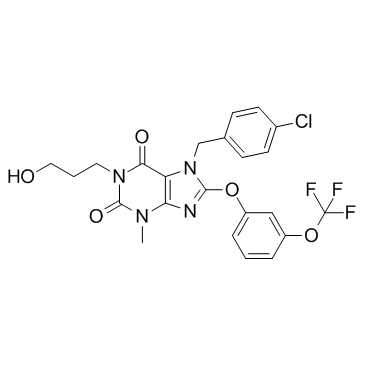| Description |
Pico145 is a remarkable inhibitor of TRPC1/4/5 channels, inhibits (−)-englerin A-activated TRPC4/TRPC5 channels, with IC50s of 0.349 and 1.3 nM in cells, and shows no effect on TRPC3, TRPC6, TRPV1, TRPV4, TRPA1, TRPM2, TRPM8.
|
| Related Catalog |
|
| Target |
IC50: 0.349 nM (TRPC4, cell assay), 1.3 nM (TRPC5, cell assay), 0.03 nM (TRPC4-TRPC1, cell assay), 0.2 nM (TRPC5-TRPC1, cell assay)[1]
|
| In Vitro |
Pico145 (Compound 31, C31) is a remarkable small-molecule inhibitor of TRPC1/4/5 channels, inhibits (−)-englerin A-activated TRPC4/TRPC5 channels, with IC50s of 0.349 and 1.3 nM in cells; Pico145 shows no effect on TRPC3, TRPC6, TRPV1, TRPV4, TRPA1, TRPM2, TRPM8. Pico145 also inhibits human TRPC4-TRPC1 and TRPC5-TRPC1 concatemers expressed in HEK 293 Tet+ cells (IC50, 0.03 nM and 0.2 nM, respectively). The potency of Pico145 can be reduced by increased (−)-englerin A concentration. Furthermore, Pico145 potently inhibits RPC4-TRPC1 channels activated by sphingosine 1-phosphate (S1P), and suppresses S1P-evoked Ca2+ entry through TRPC4-TRPC1 channels with an IC50 of 0.011 nM. Pico145 also sensitizes EA-sensitive cancer cell line (Hs578T cells) (IC50, 0.11 nM). Pico145 (100 nM) lacks effect on store-operated Ca2+ entry and histamine-evoked Ca2+ entry into endothelial cells[1].
|
| Cell Assay |
Cells are seeded at 90% confluence into 96-well clear-bottomed poly-d-lysine-coated black plates for HEK 293 cells and clear-bottomed Nunc plates for A498 cells, Hs578T cells, and HUVECs 24 h before experimentation. Fura-2 Ca2+ indicator dye is used to monitor changes in intracellular ionized Ca2+ concentration. To perform the experiment, the cells are incubated for 1 h with fura-2-AM (2 μM) in standard bath solution (SBS) at 37°C in the presence of 0.01% pluronic acid. SBS contains 135 mM NaCl, 5 mM KCl, 1.2 mM MgCl2, 1.5 mM CaCl2, 8 mM glucose, and 10 mM Hepes (pH titrated to 7.4 using NaOH). Subsequently, the cells are washed twice with SBS before adding Pico145 or ML204 for 30 min before making Ca2+ measurements. The fura-2 fluorescence is recorded using a 96-well fluorescence plate reader and the excitation wavelengths of 340 and 380 nm. For TRPV4 recordings, fluo-4/AM is used in place of fura-2/AM, and 2.5 mM probenecid is included to inhibit leak of fluo-4. Fluo-4 is excited at 485 nm, and emitted light is collected at 525 nm. Ca2+ is indicated by the ratio of the fluorescence (F) emission intensities for the two excitation wavelengths. Measurements are made at room temperature (21 ± 3°C)[1].
|
| References |
[1]. Rubaiy HN, et al. Picomolar, selective, and subtype-specific small-molecule inhibition of TRPC1/4/5 channels. J Biol Chem. 2017 May 19;292(20):8158-8173.
|
